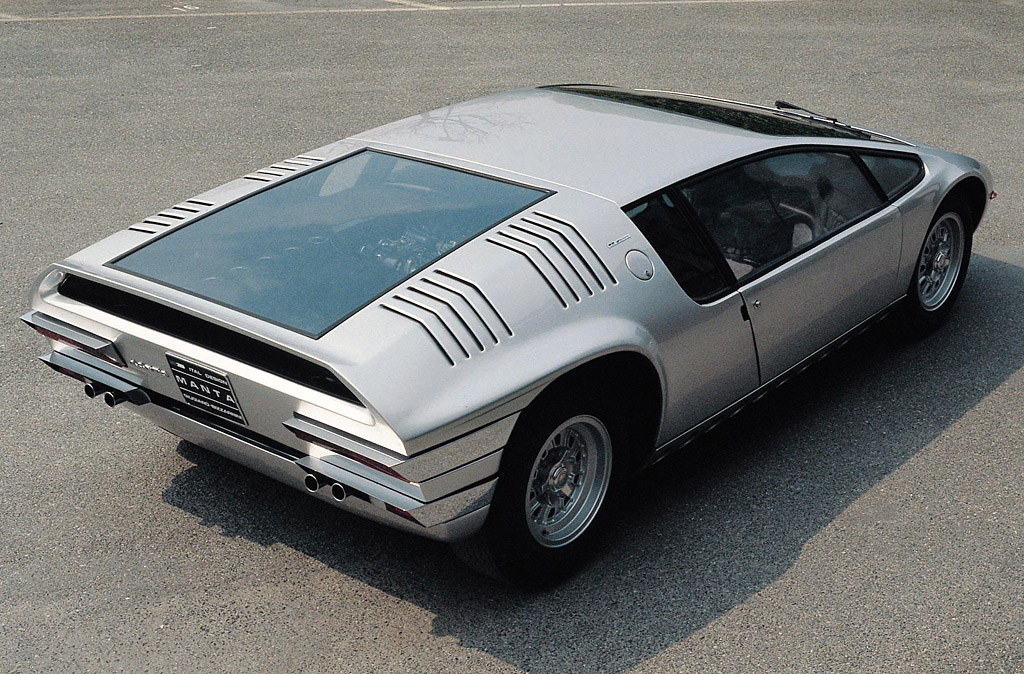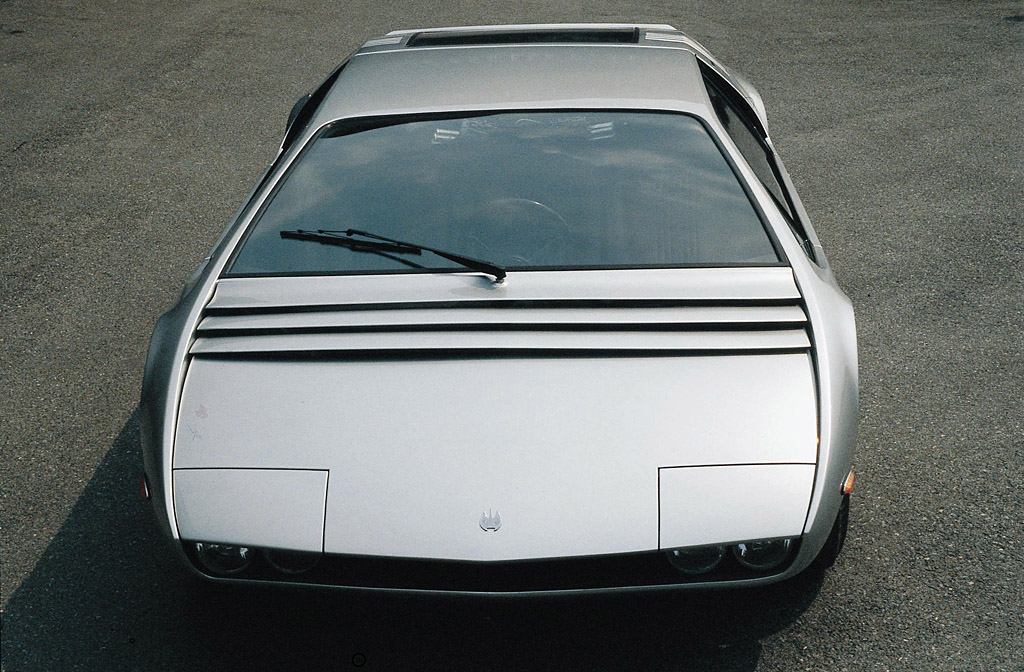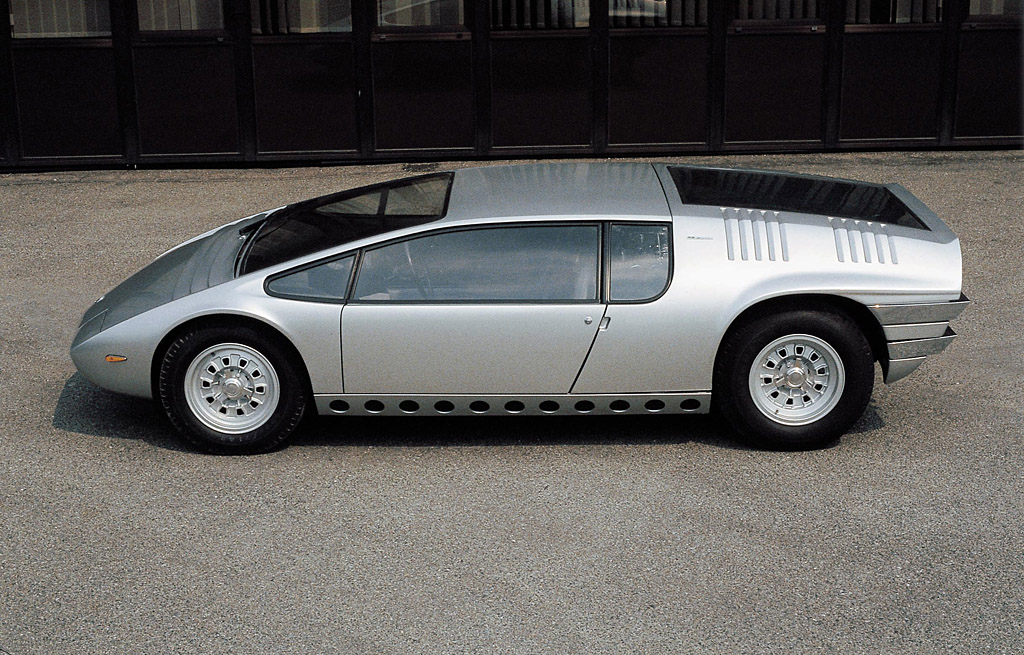1968 Bizzarrini Manta Concept
Built from Bizzarrini parts, the Manta was one of Giorgetto Giugiaro’s first independent designs as an independent consultant. He used it to promote and launch Ital Design in Turin. The Manta is remarkable as it was built up from an ex-Le Mans racer and it is one of the first cars the world to use a triple seat arrangement.
Inside the cockpit is an odd layout that seats the driver in the middle of the interior with a passenger on either side. The idea was copied from a Ferrari 365 prototype built in 1965 and it was later, more popularly revived with the mighty McLaren F1. With three people seated side-by-side it must be a particularly tight squeeze as much of the available passenger foot space is occupied by intrusive wheel wells.
Giorgetto Giugiaro had a personal interest in the car from its inception and he drew up a plan with Giotto Bizzarrini to use his most developed chassis for a radical showcar. This chassis, borrowed from the P538 prototype, was a tubular steel design that was meant to endure the hardship of Lemans and the grunt from a fully tuned Chevrolet V8. Unfortunately Giotto Bizzarrini nor Giorgetto Giugiaro can remember exactly which chassis was sourced for the Manta. Many articles claim it was a Bizzarrini P538 chassis #3 from Le Mans. Giugiaro has said “we started working on a chassis the engineer Giotto Bizzarrini obtained by modifying a model of the Grifo Competizione which had a tubular structure. We therefore took this as the starting point for our research, with a view to constructing a vehicle for the 1968 Turin Motor Show.”
An angular body, somewhat of a ‘folded paper’ design, was fixed on the chassis and finished up in time for the 1968 Turin Motorshow. A coat of lime green paint ensured that everyone had to look twice. Roat & Track reported “Giugiaro has taken the plunge and got rid of the bonnet altogether, merging the letter-box nose with the screen and the roof in one firm, rising line. The tail cuts off pleasantly with a rising curve from below, but the bold simplicity is spoiled by the Miura-style lateral slats in front of the screen, and a pointless row of holes running below the doors from front to rear. The driver sits centrally (no hand signals) with a passenger seat each side of him, which may not be ideal or even necessary, while it certainly over-widens the car. Forward visibility can’t be too good, and fixed side windows could be horribly claustrophobic. Giugiaro’s solution may not be perfect, but at least he’s had a go at the bonnet problem.”
Motor Trend’s report included “one of the major stars of the exhibit – the ‘Manta’. The car was built on the chassis of Bizzarrini’s racing prototype, which took part in the 24 Hours at Le Mans in 1967. An extremely compact car, the Manta is only 13.6 feet long and its maximum height does not exceed 41.5 inches. The car is a three-seater, the driver sitting in a central and advanced position between his two passengers. The unusual width of the car (six feet, one inch) increases the impression of compactness. Lateral visibility is exceptional. Once again, Giugiaro, Turin’s 28-year old boy genius showed new ways in car design.”
After the show the car was put on a World Tour that included the 1969 Los Angeles Auto Expo Road & Track again described the car “yet another 200-mph suppository in bright orange. A big Chevy inhabited the back along with a sort of baking tin for luggage while the lucky driver sat between his two passengers (birds, I should think) terribly close to the accident in front. Rosemeyer himself would think twice before driving that one in the wet. What with the weight distribution, venetian blinds on the nose and chrome bushbars on the rear, I am afraid that it wasn’t my cup of tea.”
After the show, the striking orange pain with black and white stripes was again covered up with a more sedate metallic silver and the car stayed this way for most of its life. It was purchased before 2003 from Texan Alfredo Brener and the next owner, Ron, who paid for a two-year restoration. The resultant turquoise show car was first shown Pebble Beach Concours, where original details such as the orange engine vents could be admired once again. Some details were changed such as the side glass which did without the original. Deservedly, it still won first in class for Class U, Chevrolet Small Block with European Coachwork.
1968 Bizzarrini Manta Concept Gallery
See full 1968 Bizzarrini Manta Concept Gallery here
In Detail
| type | Concept / Prototype Car |
| released at | 1969 Turin Motor Show |
| built at | Turin, Italy |
| production | 1 |
| engine | Chevorlet Corvette V8 |
| position | Mid Longitudinal |
| aspiration | Natural |
| valvetrain | Pushrod OHV, 2 Valves per Cyl |
| fuel feed | 4 Weber 45 DCOE Carburetors |
| displacement | 5359 cc / 327.0 in³ |
| bore | 101.6 mm / 4.0 in |
| stroke | 82.5 mm / 3.25 in |
| compression | 11.1:1 |
| power | 264.7 kw / 355 bhp @ 5800 rpm |
| specific output | 66.24 bhp per litre |
| body / frame | Aluminum Body over Bizzarrini P538 Tubular Steel Chassis |
| driven wheels | Longitudinal Rear Engine / RWD |
| steering | Rack & Pinion |
| f suspension | Double Wishbones |
| r suspension | Double Wishbones |
| wheelbase | 2500 mm / 98.4 in |
| front track | 1470 mm / 57.9 in |
| rear track | 1484 mm / 58.4 in |
| length | 4130 mm / 162.6 in |
| width | 1855 mm / 73.0 in |
| height | 1050 mm / 41.3 in |
| designers | Giorgietto Giugiaro |










